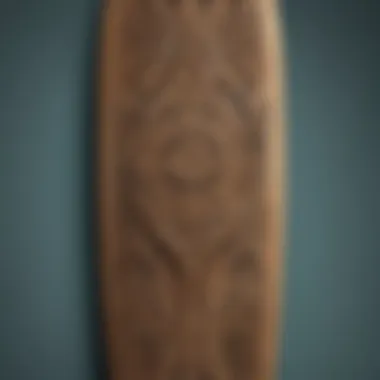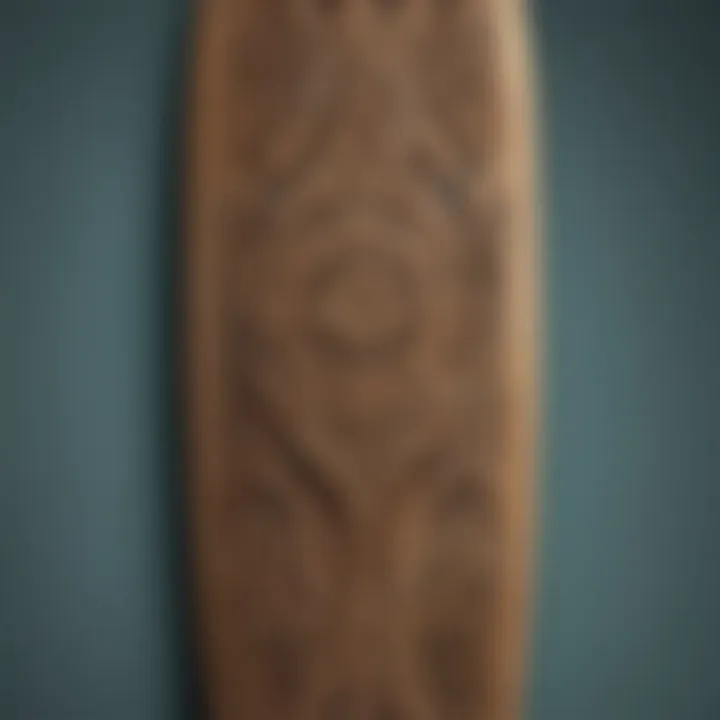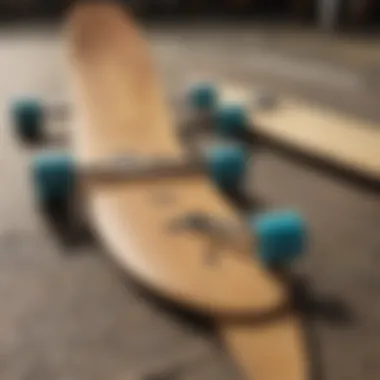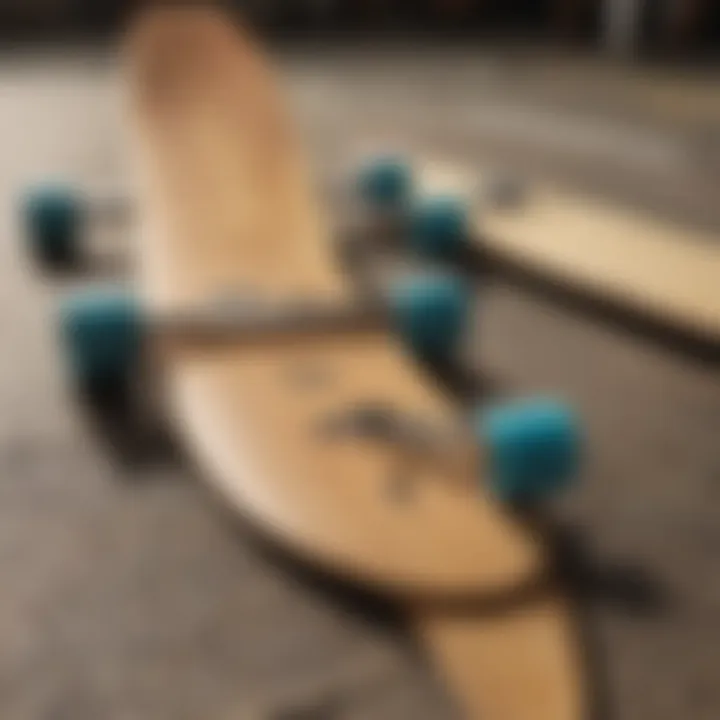Designing a Longboard: Crafting Unique Riding Experiences


Intro
When it comes to longboarding, there’s an intriguing tapestry woven from aesthetics, materials, and performance that defines a board’s character. The subtle art of longboard design is often overlooked by many riders who prioritize speed and tricks over craftsmanship. Yet, understanding the elements involved in creating a longboard can profoundly enhance the riding experience. This exploration aims to bridge that gap, diving deeply into the world of longboard design.
From the moment a rider steps onto their first board, they begin a journey that intertwines personal style with a deep appreciation for the engineering behind it. Choosing the right materials, shapes, and styles isn’t just a practical exercise; it becomes a personalized expression of the rider’s taste and style. The goal here is to illuminate the intricacies behind each decision, so whether you're a seasoned pro or a novice just starting, there’s something valuable to glean.
Understanding the core components and their relationships is essential. It’s akin to knowing the notes before you compose a symphony. Each part plays a role — from the deck shape to the choice of wheels and trucks — and together, they create a harmonious blend of style and function. Let’s embark on this detailed exploration of longboard design, grasping not only what makes a board perform but also what makes it uniquely yours.
Prelude to Longboard Design
When diving into longboard design, it’s like peeling back the layers of an onion—each layer reveals something essential about not just the board itself, but the culture and experience that surrounds it. Longboards aren't merely a means of transportation; they embody a lifestyle cherished by surfers, weekend adventurers, and commuting enthusiasts alike. Understanding longboard design is crucial for anyone who wishes to appreciate the craftsmanship, performance, and personal expression that goes into each board.
Understanding Longboarding
Longboarding is more than just gliding down a hill; it’s a blend of skill, art, and community. At its core, longboarding offers an alternative to the traditional skateboard. While both serve similar functions, longboards are generally longer, providing greater stability and versatility. This aspect appeals to a wider audience, from seasoned skaters aiming to cruise in style to newcomers seeking an effortless ride. The wider wheel base and elongated deck allow for smooth rides that can wrap around urban landscapes, coastal roads, and even rolling hills.
Moreover, the longboard's design encourages a unique connection between the rider and the terrain. It’s about feeling the world beneath your feet—the wind in your hair, the sun on your back—creating a harmonious experience that’s enhanced by the specific choices made in the design process.
History of Longboarding
The origins of longboarding can be traced back to the late 1950s and early 1960s in California, where surfers sought to replicate their favorite sport on land. Often referred to as "sidewalk surfing,” early versions of longboards were crafted from whatever materials were at hand, mainly wood and metal, leading to the eclectic designs of yesteryear.
The evolution of the longboard took significant strides with advancements in technology and material science. By the 1970s, the introduction of polyurethane wheels revolutionized how boards performed. Riders became able to tackle diverse surfaces and terrains with improved grip and stability. Today, longboarding stands as a statement of personal expression, combining various influences—from surfing and skating to a culture that thrives on adventure and freedom.
Purpose of This Guide
This guide aims to be a valuable resource for those intrigued by the nuances of longboard design. Whether you seek to craft your own board or deepen your appreciation for those skillfully made by others, understanding the various components and their interplay is vital. By discussing materials, shapes, and construction techniques, we hope to give you the fundamentals required to embark on this creative journey. As you navigate through this guide, consider the interplay between performance, aesthetics, and personal touch; each decision contributes to the overall riding experience.
"A well-designed longboard doesn’t just perform; it sings a song of its own, reflecting the character of its rider."
This article serves as an invitation to explore and understand the art and science that goes into longboard design, equipping you with the insights necessary to appreciate what makes each board truly unique.
Whether you are a surfer, instructor, lifeguard, outdoor writer, or marine biologist, the beauty of longboarding and its intricate design elements are bound to resonate with your sense of adventure and craftsmanship.
Materials: The Foundation of Longboard Design
In creating a longboard, the choice of materials plays a crucial role. It’s not just about aesthetics; the materials significantly influence weight, flexibility, strength, and durability. Understanding these factors is vital for anyone looking to design a longboard that not only looks great but performs well under the demands of various riding styles. The right materials can determine how a longboard handles turns, absorbs shocks, or sustains wear and tear over time.
Types of Wood
Maple
Maple wood is often celebrated in the longboarding community. One of its standout qualities is its impressive hardness. This contributes to the overall sturdiness of the longboard and helps in maintaining its shape even under the intense pressures of use. Maple offers a degree of shock absorption that is hard to beat, allowing for a smoother ride, especially when tackling uneven surfaces. Additionally, its tight wood grain enhances strength, making it a favorable choice for riders who engage in tricks or downhill rides.
However, the heavy nature of maple can slightly increase the overall weight of the board, which might not suit everyone’s preferences, especially if lightness is a priority.
Bamboo
On the other hand, many designers lean towards bamboo for its lightweight yet flexible properties. Bamboo is a fast-growing grass, which makes it an eco-friendly alternative, ticking off boxes for environmentally conscious builders. The natural flexibility of bamboo allows for a cushioned ride that’s appreciated by those navigating rougher terrains. Unlike other woods, bamboo can bend without breaking, giving it a unique advantage in terms of durability. Yet, this flexibility might be perceived as a disadvantage by some who prefer a stiffer board for tricks or high-speed rides.
Birch
Birch wood has gained traction in longboard manufacturing thanks to its balance between flexibility and strength. It’s slightly lighter than maple but offers similar resilience, which makes it suitable for riders seeking both performance and an aesthetically pleasing board. Its whitish color and smooth finish provide a clean look, which can be easily varnished or painted, allowing for creative expression in design. However, birch is not as widely recognized as maple or bamboo in the longboarding scene, potentially making it harder to source for some.
Alternative Materials
Fiberglass
Fiberglass is emerging as a contender in longboard materials for its capacity to create lightweight decks without compromising strength. Its main highlight is versatility; fiberglass can be infused with varying levels of epoxy to customize the board’s characteristics. You can create a board that feels stiff or has just a bit of flex, depending on rider preference. While it provides excellent impact resistance, the downside is its cost and the fact that it requires more complex manufacturing processes, which can lead to longer production times.
Carbon Fiber
Similar to fiberglass, carbon fiber brings to the table a combination of lightness and strength but with an added edge in terms of performance. It exhibits low thermal expansion, meaning it retains its properties well under various weather conditions. This is particularly beneficial for riders in differing climates, from sweltering sun to wet conditions. Additionally, carbon fiber boards can be constructed thinner than their wood counterparts. That said, price is often a significant barrier since carbon fiber can be quite expensive compared to traditional woods.
Plastic Composites
Finally, plastic composites have found their niche in the realm of longboarding, appealing to budget-conscious enthusiasts. These materials are lightweight and can be molded into various shapes, offering endless design possibilities. Though they tend to not have the same responsiveness or feel as wood, they provide adequate durability for casual riders or those just beginning. The con is that these boards may lack the aesthetic value many riders seek, often seen as less 'authentic' compared to wooden longboards.
"Selecting the right material is pivotal for achieving the perfect balance of durability, weight, and flexibility in longboard design."
Each of these materials brings something different to the table. The choice largely depends on your personal riding style, budget, and priorities in both function and appearance.
Longboard Shapes and Designs
In crafting the longboard, the shape plays a crucial role in determining performance, maneuverability, and overall riding experience. A longboard's design isn't just a matter of aesthetics; it directly impacts how the rider interacts with the surface beneath their feet. As longboarding gains traction as both a sport and leisure activity, understanding the different shapes allows enthusiasts to tailor their boards to their unique style and riding conditions.
Popular Longboard Shapes
Choosing the right shape can mean the difference between a smooth ride and a bumpy experience. Each longboard shape brings a distinct personality, catering to varied preferences and riding styles. Here, we'll explore three notable shapes: Drop-Through, Top-Mount, and Concave.
Drop-Through
Drop-through longboards have a unique design where the deck sits lower, making it easier to push off while riding. The trucks are mounted through the deck rather than on top, which lowers the center of gravity. This characteristic translates into enhanced stability.
The drop-through shape is particularly beneficial for commuter riders or those who enjoy cruising at slower speeds, as it offers a comfortable ride and smooth turns. However, while the lower deck height contributes to stability, it may also limit the ability for high-speed downhill rides due to reduced ground clearance. Riders seeking agility might find this shape lacking.


Top-Mount
Top-mount boards feature a design where the trucks are mounted directly under the deck. This configuration is marked by its high responsiveness, giving riders a more direct connection to the board. With a higher center of gravity, turning becomes easier and more dynamic.
Popular among downhill riders, the top-mount shape encourages aggressive carving and rapid maneuvering. It’s a solid choice for those chasing speed and excitement. On the flip side, the higher deck can make it more challenging for beginners to stabilize, especially at slower speeds, which demands some practice to master.
Concave
Concave shapes are notable for their upward curves along the edges of the board, creating a sort of bowl effect. This design ensures that the rider's feet are nestled into the contours of the board. The snug fit provides unparalleled control and is ideal for technical tricks and sharp turns.
Concave boards are flattering for riders looking to hone their skills and explore various tricks. Yet, they may not be the best fit for beginners who might appreciate a more forgiving flat surface as they find their footing.
Customized Shapes for Performance
The beauty of longboard design lies in its flexibility for customization. Inspired by the pursuit of personal flair and performance, many riders venture into creating a board that speaks to their riding style. Adjusting the shape can improve aspects like balance, speed, and even aesthetics for that signature look. Personalization allows each longboarder to express their riding identity, combining function with artistry.
Deck Construction Techniques
In the world of longboard design, deck construction techniques stand as a cornerstone, influencing not only the structural integrity but also the riding experience. The way a longboard deck is built can greatly affect its performance and durability. Understanding the specifics of deck construction can guide enthusiasts in choosing a board that not only meets but also exceeds their expectations.
The choice of construction technique affects everything from flex to weight distribution. A well-constructed deck can ensure a smooth ride while maintaining control at high speeds. But how do various techniques stack up against each other? Let’s explore.
Laminating Techniques
Laminating plays a pivotal role in determining the deck’s flexibility and strength. This process involves gluing together multiple layers of wood, effectively creating a composite material that can withstand stresses and strains during riding.
There are several key benefits of using laminating techniques:
- Improved Flexibility: By varying the thickness and type of wood, designers can achieve different levels of flex. This is crucial for riders who enjoy cruising on smooth surfaces versus those who tackle rough terrains.
- Enhanced Durability: A laminated deck tends to be more resilient against impacts and wear, extending the lifespan of the board.
- Aesthetic Appeal: The different layers of wood can create unique visual patterns, allowing for custom designs that resonate with a rider’s style.
In practice, a sandwich of high-density and low-density woods might be used to produce desired reactions and responses. Thoughtful laminate construction can turn an average longboard into a personalized piece of art that performs exceptionally.
Pressing and Shaping Process
Once laminated, the deck requires pressing and shaping to achieve the desired form. This step is where the flat composite material is transformed into a three-dimensional deck that feels natural to ride.
Utilizing heat and pressure, manufacturers can achieve specific bends and curves that enhance both ergonomics and performance. Here are important aspects of pressing and shaping:
- Precision Engineering: The pressing process needs to be true to ensure that every board is the same as the last one, promoting consistency in production.
- Custom Shapes: Designers often experiment with different shapes to cater to specific riding styles, be it cruising, carving, or downhill racing.
- Performance-oriented Profiles: A well-shaped deck can lower the center of gravity, improving stability while allowing for sharper turns.
The method of pressing and shaping not only impacts ride quality but can also influence how many tricks a rider can execute effortlessly.
When building a longboard, remember that the deck is your canvas. Each layer and shape tells a story about riding style and desired performance.
In summary, the techniques of laminating and pressing are essential in the world of longboard construction. By mastering these processes, designers can create decks that are not only functional but also a joy to ride, blending aesthetics with performance seamlessly.
Choosing the Right Trucks
Selecting the right trucks for your longboard is no trifling matter. Trucks hold the significant responsibility of connecting your deck and wheels, serving not just as a bridge, but also as a pivotal point influencing your board’s performance and stability. With various designs and configurations out there, making a well-informed decision can dramatically enhance your riding experience. Here, we will dive into why truck design is crucial and what to consider when choosing between different types.
Importance of Truck Design
Truck design plays an essential role in how a longboard behaves while riding. This includes the turning capabilities, stability at high speeds, and overall comfort during the ride. By focusing on the geometry and the materials used in truck construction, you can tailor the board to suit your specific riding style.
One major consideration is the height of the truck. Tall trucks can provide a higher center of gravity, which is beneficial for tricks but may compromise stability during high-speed rides. On the other hand, low trucks are designed for stability and ease of pushing, making them perfect for cruising or down-hill rides.
Another core design factor is the width of the truck, which should match your board’s width for optimal performance. Narrow trucks can lead to a twitchy ride, while wider trucks significantly improve stability, particularly during turns.
"Truck design influences everything from handling to comfort. When in doubt, test out various setups to see what fits best for your style."
Different Types of Trucks
When it comes to choosing longboard trucks, understanding the differences between standard trucks and longboard-specific trucks can help fine-tune your choice.
Standard Trucks
Standard trucks are designed primarily for skateboards and are quite versatile. They typically exhibit a traditional kingpin design, enabling effective turning and carving. The key characteristic of standard trucks is their availability in various widths and heights, providing options for different riding preferences. Many riders find them beneficial because they are widely used and readily available.
The unique feature about standard trucks is their compatibility; you can interchange them with many skateboards, which many find appealing. However, they may not always provide the stability needed at higher speeds or while performing long, flowing slides, which can lead to some inherent disadvantages in longboarding setups.
Longboard-Specific Trucks
On the other hand, longboard-specific trucks are meticulously designed with the unique needs of longboarders in mind. They often feature a wider base and a deeper angle, allowing for more fluid turns and better stability, particularly in downhill riding scenarios. The significant aspect of longboard-specific trucks is their focus on stability and comfort over tricks, which aligns well with cruising or performing slides.
The most compelling unique feature of these trucks is their customizable nature. Riders frequently have the option to adjust the tightness of their kingpin, allowing for more or less responsive rides based on preference. This advantage is particularly beneficial for new riders still figuring out their comfort level on a board.
Wheel Selection: A Critical Component
Choosing the right wheels for your longboard is pivotal to its performance, feel, and overall riding experience. While many might glance at aesthetic aspects, it's the functional nuances of wheel selection that frame the backbone of a successful ride. Every longboard enthusiast, whether a seasoned rider or a beginner, should grasp the varying elements influencing wheel choices. The wheels serve as the primary contact point with the ground, which can significantly affect speed, grip, and comfort. In essence, selection goes beyond just picking a pretty color; it’s an intricate decision-making process that requires a balanced view of several factors.
Wheel Hardness and Size
When it comes to longboard wheels, hardness and size are two fundamental parameters. The hardness of wheels, often measured on a durometer scale, dictates how the wheel responds upon hitting a surface. Softer wheels, usually in the range of 78A to 87A, provide better grip and smoother rides over rough terrains, making them ideal for downhill cruising. In contrast, harder wheels, rated from 88A to 101A, are favored for tricks or park skating, ensuring fewer flat spots but sacrificing grip on uneven surfaces.
The size of the wheel, typically ranging from 50 mm to 75 mm, also plays a critical role. Larger wheels tend to roll over obstacles more easily and offer enhanced speed, whereas smaller wheels provide improved maneuverability. Riders need to carefully match the hardness and size to their intended use to achieve optimal performance.


Materials Used in Wheels
The composition of the wheel itself also influences performance, durability, and riding comfort. The most prevalent materials used are polyurethane and a mix of synthetic materials, each with its unique properties.
Polyurethane
Polyurethane is the go-to material for most longboard wheels, and it's easy to understand why. A defining characteristic of polyurethane is its durability combined with the ability to provide a smooth ride. Compared to other materials, it excels in absorbing impact and adds a layer of comfort for the rider. The unique feature of polyurethane wheels is their ability to maintain grip over a variety of surfaces while still allowing for extensive slide, which is essential for many longboarders. On the downside, they may wear out faster when frequently used on rough terrains, so selecting the right wheel specific to your riding environments becomes crucial.
Other Synthetic Materials
There are various other synthetic materials made into wheels that offer unique advantages. These can vary based on the specific blend used in the manufacturing process, with some focusing on shock absorption or extended wear resistance. One notable attribute is that they can offer a lower cost alternative to traditional polyurethane wheels; however, they might sacrifice some grip and comfort in the process. While they might intrigue budget-conscious surfers, the trade-offs often have a direct impact on performance. Hence, care should be taken to assess how these materials might align with an individual’s riding style.
"In the end, the wheels are your connection to freedom; choosing the right pair defines the boundaries of your riding adventures."
Ultimately, the right wheel selection depends on balancing these various elements according to your personal riding style and preferences. As technology evolves, so do materials and designs, so staying abreast of trends helps in navigating your longboard experience as shifts in preferences redefine the landscape of riding domains.
Bearings and Maintenance
When it comes to longboard design, bearings and maintenance weave an essential thread through the fabric of performance and longevity. Bearings, though often overlooked, play a critical role in the overall functionality of a longboard. They are the unsung heroes that ensure a smooth ride, allowing wheels to spin freely and efficiently. This section dives into the significance of bearings and maintenance, providing insights on their construction, selection, and upkeep.
Understanding Bearings
Bearings are mechanical components that facilitate smooth rotation between moving parts. On a longboard, they sit inside the wheels, connecting them to the axle and allowing for an effortless glide.
Here are a few key aspects to grasp:
- Construction: Bearings are generally made of steel or ceramic and consist of an outer race, inner race, balls, and a retainer. Each element must work in harmony to minimize friction while supporting weight.
- Types: There are different types of bearings often referred to in the skating community, such as ABEC-rated bearings, which indicate precision and tolerances. However, many longboarders argue that factors like durability and riding style can be more critical than just the ABEC rating.
- Sealed vs. Open: Sealed bearings have caps to prevent dirt from entering, making them ideal for outdoor environments, while open bearing designs are usually easier to clean. Choosing one over the other largely depends on where and how you ride your longboard.
Regular Maintenance Practices
Just like any finely-tuned piece of equipment, longboards require regular maintenance to keep them in tip-top shape. Sure, it can be a hassle sometimes, but think of it as an investment in your riding experience. Here are some best practices to adhere to:
- Cleaning: Remove the wheels and pop out the bearings. Give them a good clean using a bearing cleaner solution or lighter fluid. Dry them thoroughly before applying new lubricant.
- Lubrication: A good-quality lubricant helps reduce friction and prolongs the life of your bearings. Apply a few drops of specialized bearing oil or grease—just don’t overdo it, as excess lubricant can attract dirt.
- Inspection: Regularly check bearings for any signs of damage, rust, or wear. If you notice anything out of the ordinary, replacing them early can save you from losing performance later on.
- Wheel Rotation: Rotating your wheels every so often ensures even wear and can extend the lifespan of both wheels and bearings.
Tip: Remember that maintaining your bearings is like keeping your engine healthy; when they run well, everything else feels better. A well-maintained longboard not only offers a smoother ride, but it also enhances safety by preventing potential accidents caused by faulty components.
Taken together, understanding your bearings and committing to maintenance are pivotal for anyone serious about longboarding. With the right tools and knowledge, you can keep your longboard rolling smoothly for years to come.
Aesthetics and Customization
When it comes to longboard design, aesthetics and customization are not merely about how the board looks, but they reflect the rider's identity, taste, and personal style. This section explores why these elements are significant in longboard design, considering aspects like individuality, visual appeal, and the balance between form and function.
The connection between a rider and their longboard can often be described as a partnership. A beautifully designed board turns heads, inviting admiration and even sparking conversations. Beyond just being a mode of transportation, the longboard becomes an extension of the rider. Consequently, when selecting a longboard, one should consider details that go beyond mere function; how it resonates with one's individuality contributes greatly to the overall experience.
Additionally, customization enhances user engagement. A rider may not only want to select their deck design but also choose graphics and color schemes that represent their personality. This personalization fosters a sense of pride and ownership that elevates the riding experience beyond the surface level.
Artwork and Graphics
Graphics serve as the canvas of self-expression on a longboard. Whether it’s a bright, hand-painted design or a sleek, digital graphic, the artwork embellishes the board while telling a unique story about its owner.
When considering artwork, some riders prefer intricate designs featuring geometric patterns, while others might opt for natural motifs like waves or forests. The choice of imagery can evoke particular feelings or memories, making the board not just a tool but a cherished piece of art in motion. Various artists and designers specialize in creating custom graphics specifically for longboards, offering riders numerous avenues to explore their creative side.
Choosing durable materials for graphics is crucial, too. For instance, vinyl wraps or heat-transfer prints can withstand the wear of riding and environmental elements, ensuring that the board remains visually appealing over time. Riders should keep in mind that the choice of artwork might also influence the board’s resale value. A well-crafted, aesthetically pleasing board is likely to hold its value better than one with generic or poorly executed graphics.
Functional vs. Decorative Elements
While aesthetics play a significant role, the balance between functional and decorative elements remains vital. Some features of longboard aesthetics need to enhance performance while keeping the design appealing.
For instance, grip tape is not just a safety feature; it provides a playground for creativity. Colors and textures can be combined to create visually striking grip designs that ensure safety while complementing the overall look of the board.
Moreover, board shapes themselves can reflect aesthetic choices that influence how a board rides. For example, a drop-through deck may boast a sleek appearance that appeals to cruisers who enjoy a smooth ride, while a pintail shape often signals a surf-inspired aesthetic that resonates with those who wish to carve and dance through streets.
Ultimately, the intersection of aesthetics and functionality creates a rich tapestry, allowing riders to express themselves while reaping the benefits of a well-designed board. Each scrawl of the artist, every texture chosen, all contribute to a piece that’s more than just an object – it's an experience to be savored with every roll, tuck, and glide.
"Design is not just what it looks like and feels like. Design is how it works." – Steve Jobs
Test and Feedback: The Design Cycle
The process of designing a longboard goes beyond just selecting materials and creating shapes. It necessitates a cycle where testing, feedback, and refinement come into play. This section expounds on how crucial this developmental step is in ensuring that the final product is not just workable but also enjoyable for the rider.
In the realm of longboarding, the phrase "you don't know until you try" couldn't ring more true. Testing prototypes allows designers to see their creations in action, evaluating performance, stability, and comfort. The design cycle integrates real-world experiences, an aspect that can't be captured in sketches or specs alone. The feedback loop from these tests drives the iterative process of refinement and customization, ensuring that every nuance of design aligns with user needs.
Prototype Testing
Prototype testing is the first and foremost step in evaluating a longboard's design. It involves creating a tangible version of the longboard, which is then subjected to various riding conditions. This can include everything from cruising flat streets to navigating steep hills. Each test runs provides invaluable insights; for instance, a prototype may show that the deck flexes too much, which translates into a less stable ride.
Moreover, the testing environment plays a pivotal role in this phase. Conducting tests in diverse settings enables designers to determine how their boards perform in various conditions, whether the terrain is rough or smooth, flat or hilly. Riders should take notes on factors like:
- Stability: Does the board wobble or feel secure?
- Turn Radius: How easily does it turn?
- Comfort: Is the ride pleasant over long distances?
- Grip: Does it handle sudden stops or sharp turns well?
Afterward, compiling this data helps identify strengths and weaknesses within the longboard design. Moreover, it cultivates an understanding of how different components interact with each other, potentially leading to innovative adjustments or entirely new concepts.
Incorporating User Feedback


Once the initial testing phase is complete, incorporating user feedback is the next logical step. Input from other riders—whether they are seasoned veterans or newcomers—is critical to refining a longboard’s design. They can contribute diverse perspectives that might not be apparent to just the designer.
User feedback can include a range of opinions from comfort to practicality. For example, a rider might suggest that the grip tape on the board is too coarse, making it uncomfortable for long rides. Others might feel that the wheel durometer affects their speed and needs adjustment. The key is to create an avenue for open dialogue; this could be through surveys, interviews, or even social media channels like reddit.com.
Some consideration points for integrating feedback include:
- Surveys or Interviews: Collecting opinions systematically provides tangible data that can guide design choices.
- Testing with Diverse Riders: People with different skill levels or riding styles will yield varied feedback, enriching your understanding of how the longboard can be improved.
- Iterative Improvements: Each cycle of testing and feedback yields clearer insights for the next prototype, leading to a more refined product with each iteration.
The cyclical nature of testing and incorporating feedback culminates in a well-rounded understanding of user experience. This informed approach not only enhances the effectiveness of the board itself but also cultivates a deeper connection with the longboarding community, which ultimately fuels the passion for innovation.
Safety Considerations in Longboard Design
When it comes to longboard design, safety isn’t just an afterthought; it's fundamental. Longboarding can be an exhilarating experience, but if the design doesn’t account for safety, it can lead to serious consequences. Designers must be vigilant about several aspects that ensure riders maintain their balance, comfort, and protection. Incorporating effective safety features not only enhances the riding experience but also builds trust among enthusiasts and newcomers alike. Here are specific elements that underscore the significance of safety in longboard design.
Impact Resistance
Impact resistance involves how well a longboard can withstand collisions, drops, or rough surfaces. The material used in the deck and the overall construction play critical roles.
- Deck Material: The choice of wood—be it maple, bamboo, or birch—has profound implications. For instance, bamboo’s natural flexibility might absorb shocks better than rigid alternatives, reducing the likelihood of breakage during a tumble.
- Design Integrity: Engineers often run simulations to gauge how longboards respond during high-intensity use. Those that are poorly designed can crack or splinter under stress. The more resilient a board, the safer it is for the rider.
- Testing Standards: Besides just the initial impact, ongoing testing should be standard fare in the industry. Endurance tests will indicate how a board performs over repeated use, ensuring reliability for riders who push their limits.
Consider this: "A board that’s strong enough to withstand the rough and tumble of real-world use is one that can give a rider the confidence to engage in the sport wholeheartedly."
Ergonomics in Design
Ergonomics focuses on how the design interacts with human capabilities and limitations. It’s about creating a longboard that not only fits the rider’s style but also promotes a safe, comfortable, and efficient riding posture.
- Foot Placement: The design should allow for an optimal foot stance. Riders who stand awkwardly are prone to losing their balance, which is often the cause of falls. A well-shaped deck affords varied foot placements for different riding styles.
- Cut-outs and Flexibility: Implementing cut-outs in the deck can help prevent wheel bite, which occurs when the wheels touch the board during sharp turns, often leading to a sudden stop and spills. Flexibility in materials enhances shock absorption, balancing out the ride and providing a smoother experience.
- Handle Designs: For longer boards, adding handles can facilitate easier carrying without compromising safety. This ergonomic feature may be overlooked but can significantly improve user experience.
Through proper ergonomics, designs can mitigate potential mishaps, allowing riders to feel in control, ultimately keeping them safer on their journeys.
In summary, keeping safety at the forefront of longboard design is crucial. Impact resistance and ergonomic principles are intertwined; one cannot thrive without the other. Designers have an immense responsibility to craft boards that not only cater to the thrill-seeking spirit but also ensure a secure environment for every rider.
Environmental Impact and Sustainability
In today's world, where environmental considerations can no longer be pushed to the sidelines, it is crucial to examine the environmental impact associated with longboard designs. This aspect doesn't just touch on the materials used or the manufacturing techniques; it permeates the entire lifecycle of a longboard, from inception to disposal. Sustainable practices are taking center stage in the design realm, offering a pathway to creating products that respect our planet while still delivering quality performance and aesthetics.
Eco-friendly Materials
The selection of materials plays a starring role in reducing the ecological footprint of longboards. For instance, opting for sustainable varieties like bamboo can make a significant difference. Bamboo is fast-growing and requires fewer resources compared to traditional hardwoods—less water and no pesticides. This means that the ecological disruption when harvesting bamboo is considerably lower. Additionally, recycled materials are gaining traction in the longboarding community; these may include plastic from ocean debris or reclaimed wood, which breathe new life into materials that otherwise contribute to pollution.
Moreover, some manufacturers are exploring innovative options like natural resins and plant-based glues instead of conventional synthetic ones. These options not only perform well but also break down more readily in the environment, leading to a lesser impact when a longboard's life comes to an end.
"With each longboard crafted from eco-conscious materials, we’re not just shaping our rides; we’re shaping a more sustainable future."
Responsible Manufacturing Practices
But choosing the right materials is just one piece of the puzzle. The manufacturing processes used to produce longboards have a tremendous impact on sustainability efforts as well. Utilizing energy-efficient methods can drastically reduce carbon emissions. For instance, many companies are turning to renewable energy sources—like wind or solar—during the manufacturing process.
It’s also vital for manufacturers to ensure that their facilities uphold fair labor practices. A responsible approach involves treating workers with respect and ensuring a safe working environment, as it contributes positively to community well-being. A conscientious manufacturer takes into account every step of its operation, from sourcing raw materials to shipping finished products.
Lastly, many brands are focusing on creating repairable and durable longboards. This means designing products that can withstand wear and tear over time, which ultimately translates into fewer boards ending up in landfills. Promoting a culture of repair can greatly extend product life and reduce waste, encouraging consumers to think critically about the longevity of their purchases.
As longboard designers and enthusiasts, it's essential to stay informed about our choices and behaviors that contribute to environmental sustainability. Through conscious decisions regarding materials and manufacturing practices, we not only elevate the sport but also protect the ecosystems that surround us.
Navigating Market Trends
Understanding the ever-changing landscape of longboard design is essential not only for manufacturers but also for consumers who are keen on getting the best performance for their riding style. Market trends in longboarding can reveal what’s gaining popularity and what’s fading out. Trends often reflect the preferences of the riding community, so keeping a pulse on these can offer valuable insights into the evolving needs and desires of longboard enthusiasts. Here, we delve into two key aspects of market trends: emerging designs and consumer preferences.
Emerging Designs
As riders seek more versatile and unique experiences, designers are stepping up their game. The flowing creativity in longboard design has given rise to several noteworthy trends:
- Electric Longboards: With the surge in interest for electric vehicles globally, electric longboards are carving a niche. These boards allow riders to glide effortlessly without the physical exertion of a traditional longboard.
- All-Terrain Boards: For those who can’t sit still, boards designed for rugged terrains are en vogue. They sport larger wheels and sturdier construction, ideal for both pavement and off-road riding.
- Modular Designs: Customization is a large piece of the puzzle. Emerging designs often focus on modular boards where components can be easily swapped, allowing riders to tailor their setup for various conditions.
"The evolution of longboard designs shows how creative minds can reshape user experiences while also satisfying environmental concerns."
- Sustainable Options: There's growing buzz around boards made from reclaimed woods or bio-based materials. Not only do these options resonate with eco-conscious consumers, they also reflect a deeper commitment to sustainable practices in manufacturing.
Consumer Preferences
As creators hone their craft, it’s crucial to understand what the customers want. The preferences of longboard riders are as diverse as the landscapes they traverse. Here’s where the rubber meets the road:
- Performance vs. Aesthetics: Riders often find themselves at a crossroads between performance-oriented boards and those designed for aesthetic appeal. While some prioritize grip and stability, others may lean toward vibrant graphics and artistic deck designs.
- Size Matters: Feedback indicates varying preferences in board sizes. Longboards that strike a balance between convenience and stability tend to attract more riders. A growing number are favoring boards that are easily maneuverable and not too bulky.
- Tech-Savvy Features: With the world moving toward integration with technology, more users are looking for features like built-in LED lights, Bluetooth speakers, or even GPS capabilities that can enhance their riding experience.
By closely observing these market trends, manufacturers and consumers alike can gain a clearer perspective on what the future holds for longboard design. In a sector where innovation and personal expression reign supreme, keeping up with market trends ensures that enthusiasts can either keep adapting or create the boards that resonate with their own unique riding experiences.
Culmination
In the world of longboard design, reaching a conclusion means more than just wrapping up an article; it’s about synthesizing the knowledge gained through various stages of the design process. From materials and construction techniques to aesthetics and performance testing, this guide has aimed to produce a comprehensive framework to appreciate the intricacies involved in creating a longboard.
Recap of Key Points
The longboard is more than just a means of transportation; it embodies a rich history and cultural significance, much like the surfboards that ride the waves. As we explored, the choice of materials such as maple and bamboo plays a significant role in the board's performance and durability. Moreover, the shape of the deck impacts handling and stability, catering to different riding styles.
Additionally, the importance of customizing trucks and wheels was highlighted, as these components are vital to achieving a smooth ride tailored to the user's preferences. Often, minor tweaks can lead to profound improvements in performance. We also noted that aesthetics should not be overlooked. A well-designed longboard, adorned with personal artwork or unique graphics, delivers not only functionality but also a personal touch that truly defines a rider’s style.
Finally, the practices of testing prototypes and embracing user feedback were underscored as crucial steps in refining design. Without these iterative processes, the end product may not fully meet user expectations or adapt to emerging trends in the sport.
Future of Longboard Design
Looking ahead, the landscape of longboard design seems promising and ripe for innovation. With advancements in materials science, we can anticipate lighter and stronger boards that can withstand the demands of intense riding. The homegrown DIY movement might give birth to new ideas and designs, pushing social engagement and cross-pollination of ideas among enthusiasts. Additionally, as environmental awareness grows, we are likely to see a rise in eco-friendly materials become more mainstream, transforming traditional design paradigms.
User-driven customization is also at the forefront. As technology allows for more personalization through online platforms, riders can easily obtain components that reflect their unique identities and riding styles. This individualization will likely pave the way for niche markets, specializing in bespoke longboards that cater to a variety of customer preferences.
In summary, the world of longboard design is not static. It thrives on creativity and passion, with every deck telling a story. To be part of this journey is to embrace both tradition and innovation—a balance that will continue to shape the landscape of longboarding for years to come.















